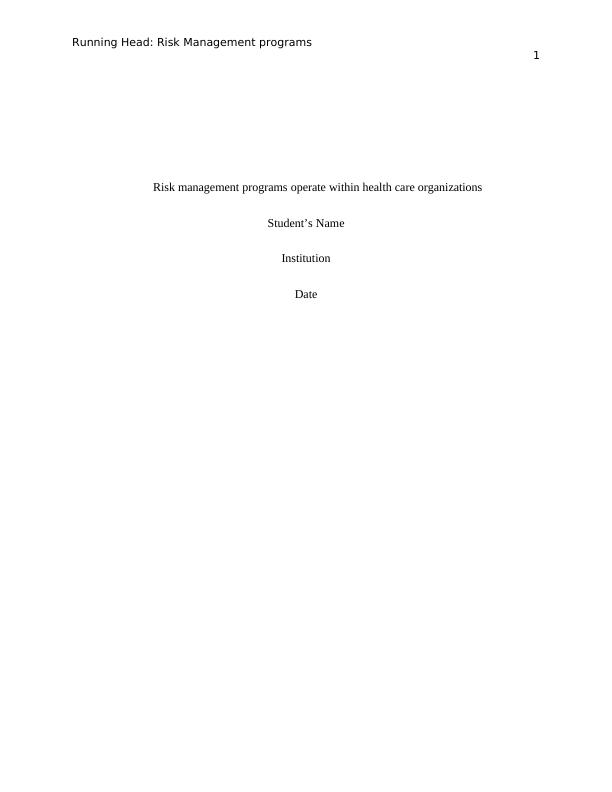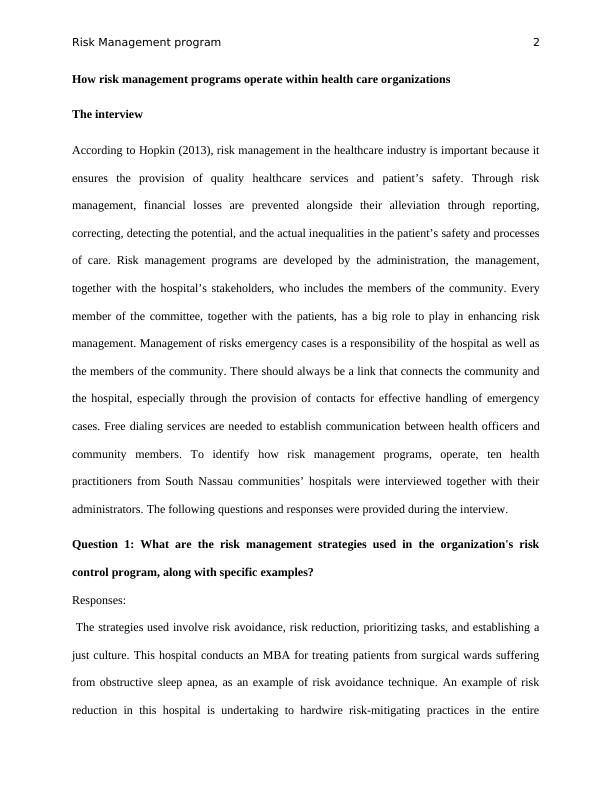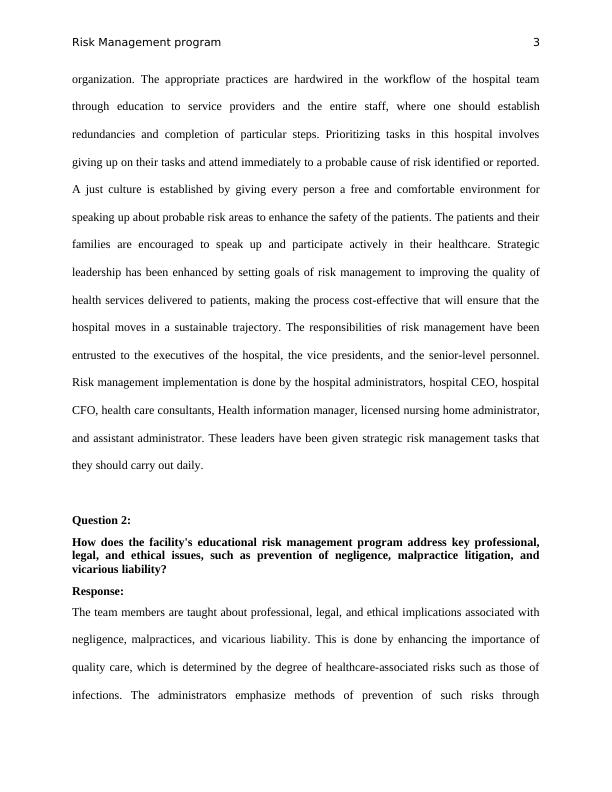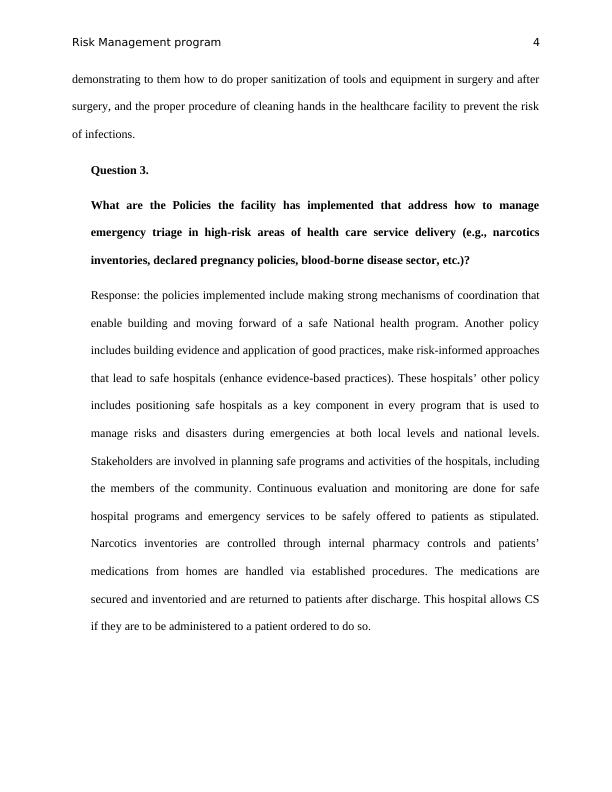Risk Management program - Assignment
Added on 2022-08-20
11 Pages2987 Words16 Views
Running Head: Risk Management programs
1
Risk management programs operate within health care organizations
Student’s Name
Institution
Date
1
Risk management programs operate within health care organizations
Student’s Name
Institution
Date

Risk Management program 2
How risk management programs operate within health care organizations
The interview
According to Hopkin (2013), risk management in the healthcare industry is important because it
ensures the provision of quality healthcare services and patient’s safety. Through risk
management, financial losses are prevented alongside their alleviation through reporting,
correcting, detecting the potential, and the actual inequalities in the patient’s safety and processes
of care. Risk management programs are developed by the administration, the management,
together with the hospital’s stakeholders, who includes the members of the community. Every
member of the committee, together with the patients, has a big role to play in enhancing risk
management. Management of risks emergency cases is a responsibility of the hospital as well as
the members of the community. There should always be a link that connects the community and
the hospital, especially through the provision of contacts for effective handling of emergency
cases. Free dialing services are needed to establish communication between health officers and
community members. To identify how risk management programs, operate, ten health
practitioners from South Nassau communities’ hospitals were interviewed together with their
administrators. The following questions and responses were provided during the interview.
Question 1: What are the risk management strategies used in the organization's risk
control program, along with specific examples?
Responses:
The strategies used involve risk avoidance, risk reduction, prioritizing tasks, and establishing a
just culture. This hospital conducts an MBA for treating patients from surgical wards suffering
from obstructive sleep apnea, as an example of risk avoidance technique. An example of risk
reduction in this hospital is undertaking to hardwire risk-mitigating practices in the entire
How risk management programs operate within health care organizations
The interview
According to Hopkin (2013), risk management in the healthcare industry is important because it
ensures the provision of quality healthcare services and patient’s safety. Through risk
management, financial losses are prevented alongside their alleviation through reporting,
correcting, detecting the potential, and the actual inequalities in the patient’s safety and processes
of care. Risk management programs are developed by the administration, the management,
together with the hospital’s stakeholders, who includes the members of the community. Every
member of the committee, together with the patients, has a big role to play in enhancing risk
management. Management of risks emergency cases is a responsibility of the hospital as well as
the members of the community. There should always be a link that connects the community and
the hospital, especially through the provision of contacts for effective handling of emergency
cases. Free dialing services are needed to establish communication between health officers and
community members. To identify how risk management programs, operate, ten health
practitioners from South Nassau communities’ hospitals were interviewed together with their
administrators. The following questions and responses were provided during the interview.
Question 1: What are the risk management strategies used in the organization's risk
control program, along with specific examples?
Responses:
The strategies used involve risk avoidance, risk reduction, prioritizing tasks, and establishing a
just culture. This hospital conducts an MBA for treating patients from surgical wards suffering
from obstructive sleep apnea, as an example of risk avoidance technique. An example of risk
reduction in this hospital is undertaking to hardwire risk-mitigating practices in the entire

Risk Management program 3
organization. The appropriate practices are hardwired in the workflow of the hospital team
through education to service providers and the entire staff, where one should establish
redundancies and completion of particular steps. Prioritizing tasks in this hospital involves
giving up on their tasks and attend immediately to a probable cause of risk identified or reported.
A just culture is established by giving every person a free and comfortable environment for
speaking up about probable risk areas to enhance the safety of the patients. The patients and their
families are encouraged to speak up and participate actively in their healthcare. Strategic
leadership has been enhanced by setting goals of risk management to improving the quality of
health services delivered to patients, making the process cost-effective that will ensure that the
hospital moves in a sustainable trajectory. The responsibilities of risk management have been
entrusted to the executives of the hospital, the vice presidents, and the senior-level personnel.
Risk management implementation is done by the hospital administrators, hospital CEO, hospital
CFO, health care consultants, Health information manager, licensed nursing home administrator,
and assistant administrator. These leaders have been given strategic risk management tasks that
they should carry out daily.
Question 2:
How does the facility's educational risk management program address key professional,
legal, and ethical issues, such as prevention of negligence, malpractice litigation, and
vicarious liability?
Response:
The team members are taught about professional, legal, and ethical implications associated with
negligence, malpractices, and vicarious liability. This is done by enhancing the importance of
quality care, which is determined by the degree of healthcare-associated risks such as those of
infections. The administrators emphasize methods of prevention of such risks through
organization. The appropriate practices are hardwired in the workflow of the hospital team
through education to service providers and the entire staff, where one should establish
redundancies and completion of particular steps. Prioritizing tasks in this hospital involves
giving up on their tasks and attend immediately to a probable cause of risk identified or reported.
A just culture is established by giving every person a free and comfortable environment for
speaking up about probable risk areas to enhance the safety of the patients. The patients and their
families are encouraged to speak up and participate actively in their healthcare. Strategic
leadership has been enhanced by setting goals of risk management to improving the quality of
health services delivered to patients, making the process cost-effective that will ensure that the
hospital moves in a sustainable trajectory. The responsibilities of risk management have been
entrusted to the executives of the hospital, the vice presidents, and the senior-level personnel.
Risk management implementation is done by the hospital administrators, hospital CEO, hospital
CFO, health care consultants, Health information manager, licensed nursing home administrator,
and assistant administrator. These leaders have been given strategic risk management tasks that
they should carry out daily.
Question 2:
How does the facility's educational risk management program address key professional,
legal, and ethical issues, such as prevention of negligence, malpractice litigation, and
vicarious liability?
Response:
The team members are taught about professional, legal, and ethical implications associated with
negligence, malpractices, and vicarious liability. This is done by enhancing the importance of
quality care, which is determined by the degree of healthcare-associated risks such as those of
infections. The administrators emphasize methods of prevention of such risks through

Risk Management program 4
demonstrating to them how to do proper sanitization of tools and equipment in surgery and after
surgery, and the proper procedure of cleaning hands in the healthcare facility to prevent the risk
of infections.
Question 3.
What are the Policies the facility has implemented that address how to manage
emergency triage in high‐risk areas of health care service delivery (e.g., narcotics
inventories, declared pregnancy policies, blood-borne disease sector, etc.)?
Response: the policies implemented include making strong mechanisms of coordination that
enable building and moving forward of a safe National health program. Another policy
includes building evidence and application of good practices, make risk-informed approaches
that lead to safe hospitals (enhance evidence-based practices). These hospitals’ other policy
includes positioning safe hospitals as a key component in every program that is used to
manage risks and disasters during emergencies at both local levels and national levels.
Stakeholders are involved in planning safe programs and activities of the hospitals, including
the members of the community. Continuous evaluation and monitoring are done for safe
hospital programs and emergency services to be safely offered to patients as stipulated.
Narcotics inventories are controlled through internal pharmacy controls and patients’
medications from homes are handled via established procedures. The medications are
secured and inventoried and are returned to patients after discharge. This hospital allows CS
if they are to be administered to a patient ordered to do so.
demonstrating to them how to do proper sanitization of tools and equipment in surgery and after
surgery, and the proper procedure of cleaning hands in the healthcare facility to prevent the risk
of infections.
Question 3.
What are the Policies the facility has implemented that address how to manage
emergency triage in high‐risk areas of health care service delivery (e.g., narcotics
inventories, declared pregnancy policies, blood-borne disease sector, etc.)?
Response: the policies implemented include making strong mechanisms of coordination that
enable building and moving forward of a safe National health program. Another policy
includes building evidence and application of good practices, make risk-informed approaches
that lead to safe hospitals (enhance evidence-based practices). These hospitals’ other policy
includes positioning safe hospitals as a key component in every program that is used to
manage risks and disasters during emergencies at both local levels and national levels.
Stakeholders are involved in planning safe programs and activities of the hospitals, including
the members of the community. Continuous evaluation and monitoring are done for safe
hospital programs and emergency services to be safely offered to patients as stipulated.
Narcotics inventories are controlled through internal pharmacy controls and patients’
medications from homes are handled via established procedures. The medications are
secured and inventoried and are returned to patients after discharge. This hospital allows CS
if they are to be administered to a patient ordered to do so.

End of preview
Want to access all the pages? Upload your documents or become a member.
Related Documents
Patient Safety and Quality Improvement | Essaylg...
|2
|846
|21
Nursing Leadership in Australia: Assignmentlg...
|21
|6732
|51
Work Health and Safety Managementlg...
|5
|1029
|221
Life Stages And Influence Of Age In Health Carelg...
|4
|905
|285
Educational Program Risk Managementlg...
|5
|808
|17
Healthcare Qualitylg...
|4
|839
|242
